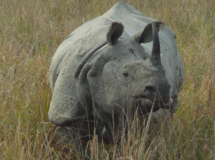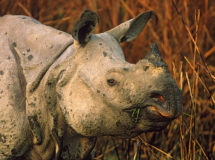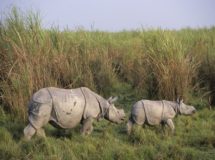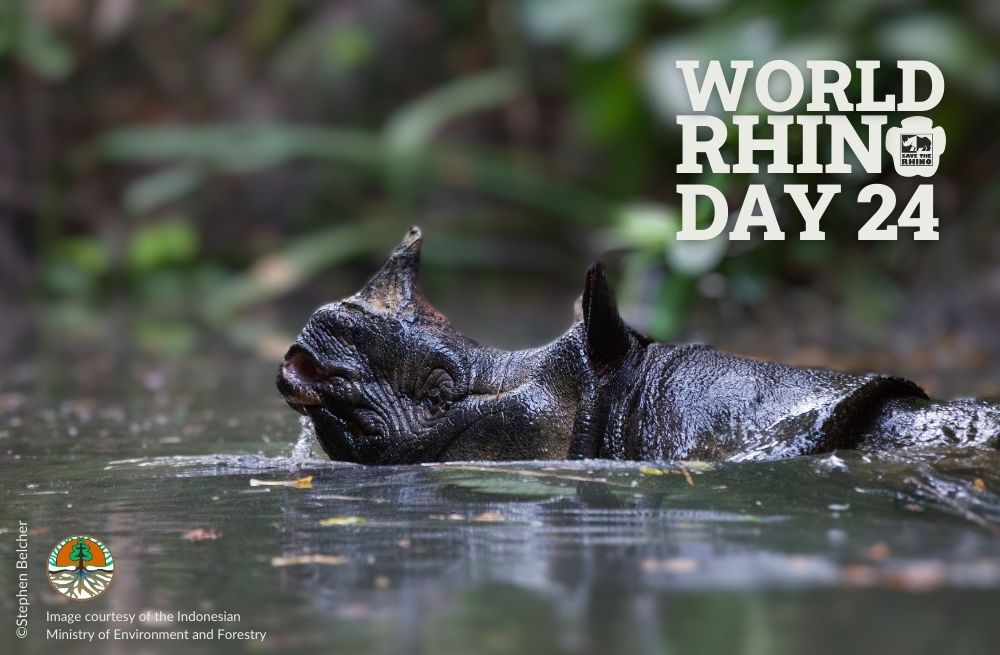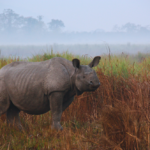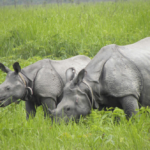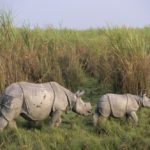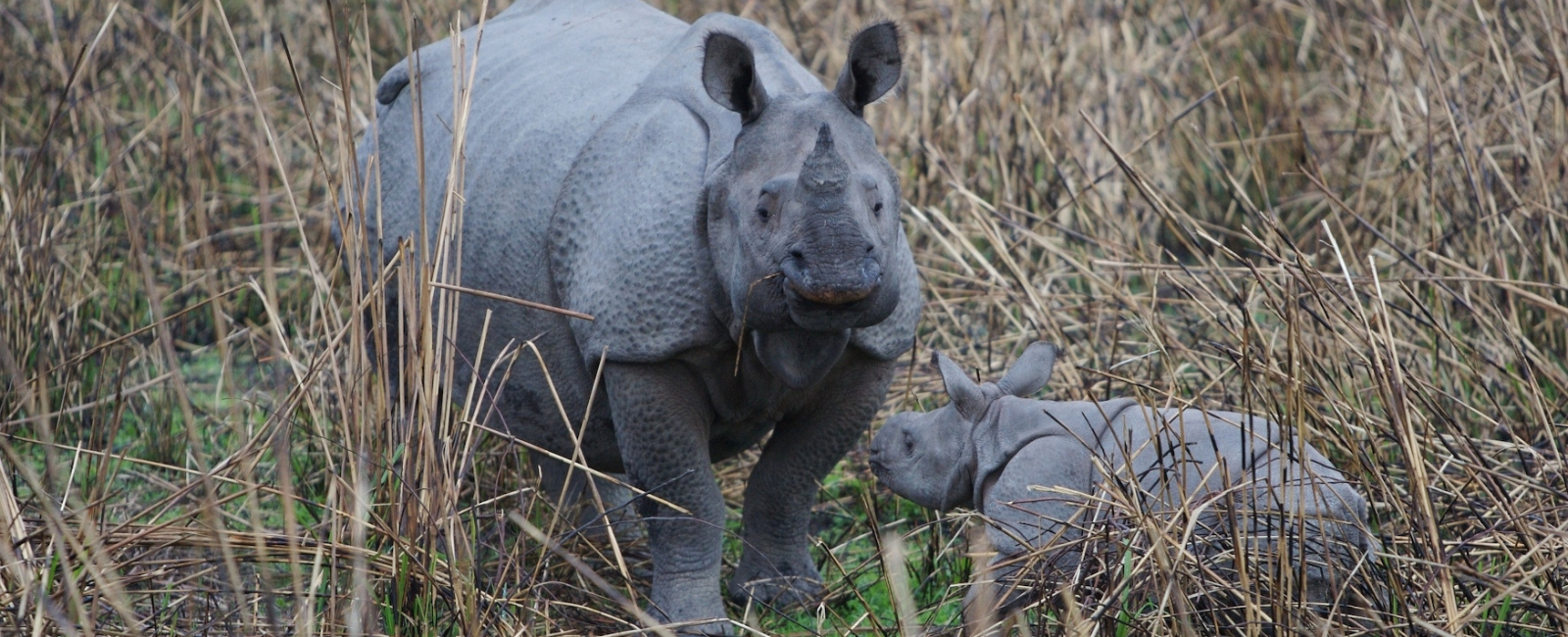
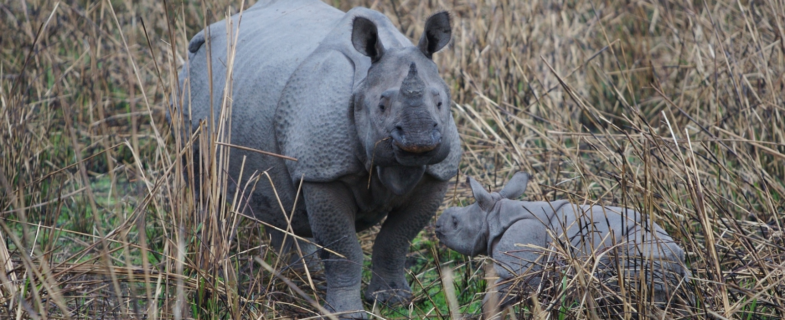
India: Assam
The Indian or (more appropriately, given its range extending into Nepal) Greater one-horned rhino is the second-largest rhino species. With a single horn and a body covered in heavy folds of skin that imitate armoured plating, this rhino gives the impression of a prehistoric species at home alongside the dinosaurs. Of course, they are not related to these reptilians, however, they are, along with the two other Asian rhino species, among the most ancient of mammals.
Assam was once home to all three of these species, but, after spending millions of years on this planet, none were resilient to the threats posed by the arrival of humanity. Hunting and habitat loss caused the local extinction of the Javan and Sumatran species by the early years of the 20th Century, whilst the Greater one-horned at this point was hanging on by a thread. Thanks to the devotion of India and Nepal’s Governments as well as conservationists around the world, what followed was one of the most successful conservation stories in history. The species’ populations rebounded, and the latest estimates are that the global population of Greater one-horned rhinos has surpassed 4,000 individuals, including more than 2,600 in Kaziranga National Park alone.
But threats remain…
The problem
In c. 1400 AD, from Pakistan in the west, across India to the northern tip of Myanmar in the east, up to 450,000 of these rhinos grazed across the great flooded grasslands and forests of the Brahmaputra River and Gangetic Plain at the foothills of the Himalayas. But being popular targets for hunting expeditions over the centuries, including by British and Indian royalty, meant that thousands were shot. Furthermore, growing human populations and demand for commodities sought after under British rule, such as tea, compounded the issue as vast swathes of the alluvial floodplains were drained and cleared. Today, individuals are now restricted to isolated pockets of suitable habitat in India and Nepal. Found in just 11 protected areas, the combined range of the species is little more than 4,000km2 (less than twice the size of the Lake District National Park).
Heavily protected, these rhinos are still threatened by poaching for their horn for use as a status symbol and within Traditional Chinese Medicines. Assam’s authorities and rangers have been highly successful in recent years at reducing poaching, from a high of 41 individuals killed in 2013 to 0 in 2022. However, it is essential that we do not become complacent as poaching gangs constantly change their methods to avoid detection. In January 2023, after just two rhinos were poached in Nepal throughout the entire seven-year period leading up to 2022, two rhinos were killed on the fringes of the country’s famous Chitwan National Park – likely by deliberate electrocution. Furthermore, in Orang National Park in 2022, one rhino survived having his horn removed by poachers whilst under anaesthesia. Of greater concern, however, despite no killings in 2022, are reports of conventional poaching in Assam resuming once more.
Finally, problems posed by its limited range and degradation of the remaining habitat pockets are only going to be exacerbated by a rapidly changing climate. Increasingly severe and unpredictable flood patterns, drought, and range expansion of invasive species, mean that growing this rhino’s range is becoming increasingly important. As a habitat specialist, the species’ ability to adapt to a fast-changing habitat is unlikely. With more than 65% of the remaining wild population concentrated in Assam’s Kaziranga National Park alone, establishing viable populations in the species’ former range is vital to mitigate the chances of extinction in the event of climate- or disease-related catastrophes.
How is Assam tackling this problem?
Previous efforts: Indian Rhino Vision 2020
In Assam, the species’ stronghold, rhinos were found in only three protected areas: Kaziranga National Park, Pobitora Wildlife Sanctuary and Orang National Park. Yet the largest of these, Kaziranga National Park, was almost at capacity. For the species to thrive, more habitats had to be found.
In 2005, conservationists, alongside the Bodoland Territorial Council and the Government of Assam, came together to develop a long-term strategy to manage the species. Their vision was ambitious; to build a 3,000-strong wild population of Greater one-horned rhinos by 2020, spread across seven sites in the state of Assam. “Indian Rhino Vision 2020” (IRV2020) was born. With funds raised by the EAZA Rhino Campaign of 2005-6, Save the Rhino was able to make grants of €92,000 and £19,100 to help pay for IRV2020 activities.
While the goal of seven populations was not achieved, the project did successfully establish a fourth population of rhinos in Manas National Park in Assam. Rhino populations also increased across all four sites during the project period, despite the poaching crisis.
Habitat expansion and restoration in Assam
After losing its rhinos during the 1990s, in 2008, the first batch of individuals was reintroduced to Manas as part of the Indian Rhino Vision 2020 implemented by the Government of Assam with the support of partners. Today, the Park hosts more than 40 individuals, however, more rhinos mean more suitable habitat and fodder is needed to sustain the growing population.
As this plan unfolds, the ongoing improvement and expansion of existing habitats is necessary to maximise their carrying capacity and form contiguous landscapes that enable the free movement of animals. In 2022, the Government of Assam did just this by expanding Orang National Park by >200km2, connecting it with the neighbouring Burachapori Wildlife Sanctuary.
Furthermore, our partner, the International Rhino Foundation, in collaboration with the local NGO Aaranyak, continues to clear and control invasive plant species in the Park that are choking out the rhinos’ preferred grasses. The project employs local people to manually uproot alien species such as American rope(Mikania micrantha) and the Siam weed (Chromolaena odorata) and plant native grasses that are palatable for the rhinos to feed on.
Whilst the rhino is the flagship species that attracts much high-profile attention, other unique and threatened species are benefitting from this habitat transformation, including: the pygmy hog (Porcula salvinia) – a very rare species of pig once thought to be extinct and only found in this region of the world; the pygmy hog-sucking louse (Haematopinus oliveri) – a louse found only on this one species of pig and nowhere else; the Bengal florican (Houbaropsis bengalensis); and the Asian elephant (Elephas maximus).
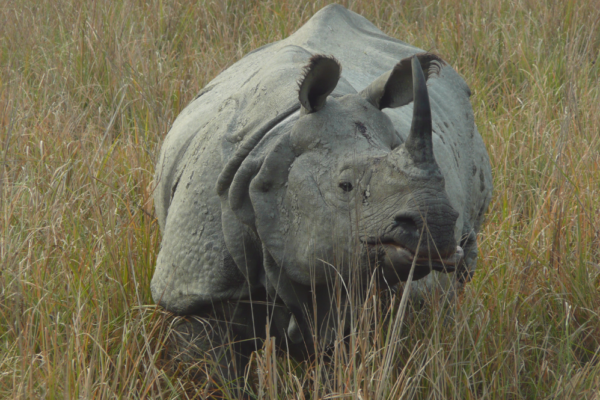

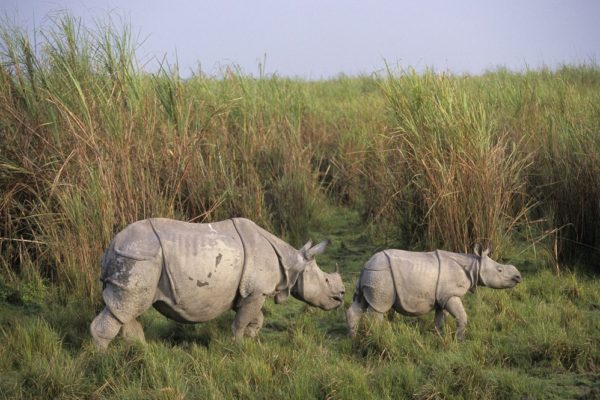
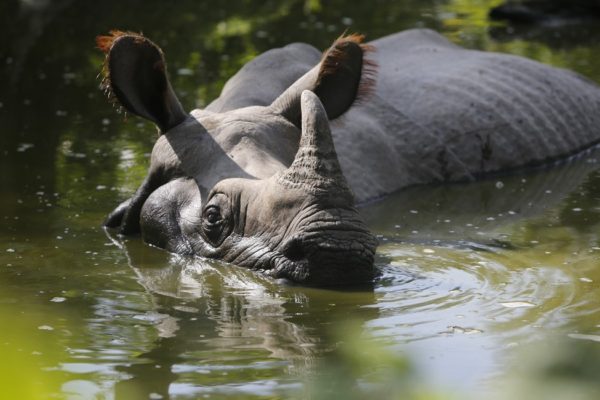
Our work
Save the Rhino International previously collaborated with the International Rhino Foundation to support the Indian Rhino Vision 2020 programme. In the past, we have contributed to the purchase of patrol vehicles and funded law-enforcement training courses.
However, with up to one-third of the Park’s potential rhino habitat compromised by invasive plant species, our most recent funding support has been focused on the removal of alien plant species in Manas National Park, to increase the habitat available without needing to expand the Park’s boundaries. Funds have also been allocated to the wildlife crime investigation and enforcement programme, which has facilitated many arrests of actual or would-be poachers. As efforts to establish new rhino populations and expand existing ones progress, we hope to contribute to this activity once again.
 Protecting Rhinos
Protecting Rhinos
 Reducing Illegal Horn Trade
Reducing Illegal Horn Trade
 Involving Communities
Involving Communities
 Bringing Experts Together
Bringing Experts Together


